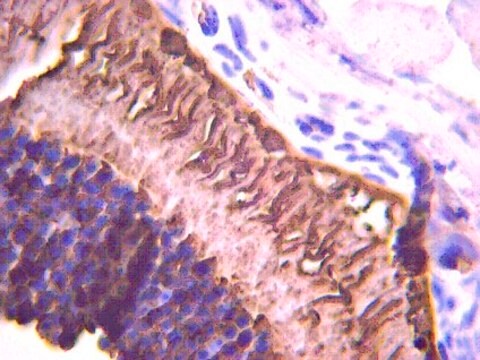Recommended Products
biological source
mouse
Quality Level
conjugate
unconjugated
antibody form
purified antibody
antibody product type
primary antibodies
clone
7G6, monoclonal
mol wt
calculated mol wt 42.67 kDa
purified by
using protein G
species reactivity
human, monkey, bovine
packaging
antibody small pack of 100 μg
technique(s)
immunofluorescence: suitable
immunohistochemistry (formalin-fixed, paraffin-embedded sections): suitable
western blot: suitable
isotype
IgG1κ
epitope sequence
N-terminal
UniProt accession no.
shipped in
2-8°C
target post-translational modification
unmodified
Gene Information
mouse ... arr3> ARR3(102134564)
General description
Specificity
Immunogen
Application
Isotype testing: Identity Confirmation by Isotyping Test.
Isotyping Analysis: The identity of this monoclonal antibody is confirmed by isotyping test to be mouse IgG1.
Tested Applications
Western Blotting Analysis: A representative lot detected Arrestin-C in Western Blotting applications (Zhang, H., et al. (2003). Invest Ophthalmol Vis Sci.;44(7):2858-67).
Immunohistochemistry Applications: A representative lot detected Arrestin-C in Immunohistochemistry applications (Wikler, K.C., et al. (1997). J Comp Neurol.;377(4):500-8; John, S.K., et al. (2000). Mol Vis.;6:204-15; Zhang, H., et al. (2003). Invest Ophthalmol Vis Sci.;44(7):2858-67; O′Brien, J.J., et al. (2012). J Neurosci.;32(13):4675-87).
Immunofluorescence Analysis: A 1:500 dilution from a representative lot detected Arrestin-C in frozen monkey retina tissues (Courtesy of Prof. Peter MacLeish, Ph.D., photo by Talib Saafir, Ph.D., Morehouse School of Medicine, Atlanta, GA, USA).
Immunofluorescence Analysis: A representative lot detected Arrestin-C in Immunofluorescence applications (Zhang, H., et al. (2003). Invest Ophthalmol Vis Sci.;44(7):2858-67).
Note: Actual optimal working dilutions must be determined by end user as specimens, and experimental conditions may vary with the end user
Physical form
Storage and Stability
Other Notes
Disclaimer
Not finding the right product?
Try our Product Selector Tool.
Storage Class
12 - Non Combustible Liquids
wgk_germany
WGK 1
flash_point_f
Not applicable
flash_point_c
Not applicable
Certificates of Analysis (COA)
Search for Certificates of Analysis (COA) by entering the products Lot/Batch Number. Lot and Batch Numbers can be found on a product’s label following the words ‘Lot’ or ‘Batch’.
Already Own This Product?
Find documentation for the products that you have recently purchased in the Document Library.
Our team of scientists has experience in all areas of research including Life Science, Material Science, Chemical Synthesis, Chromatography, Analytical and many others.
Contact Technical Service





